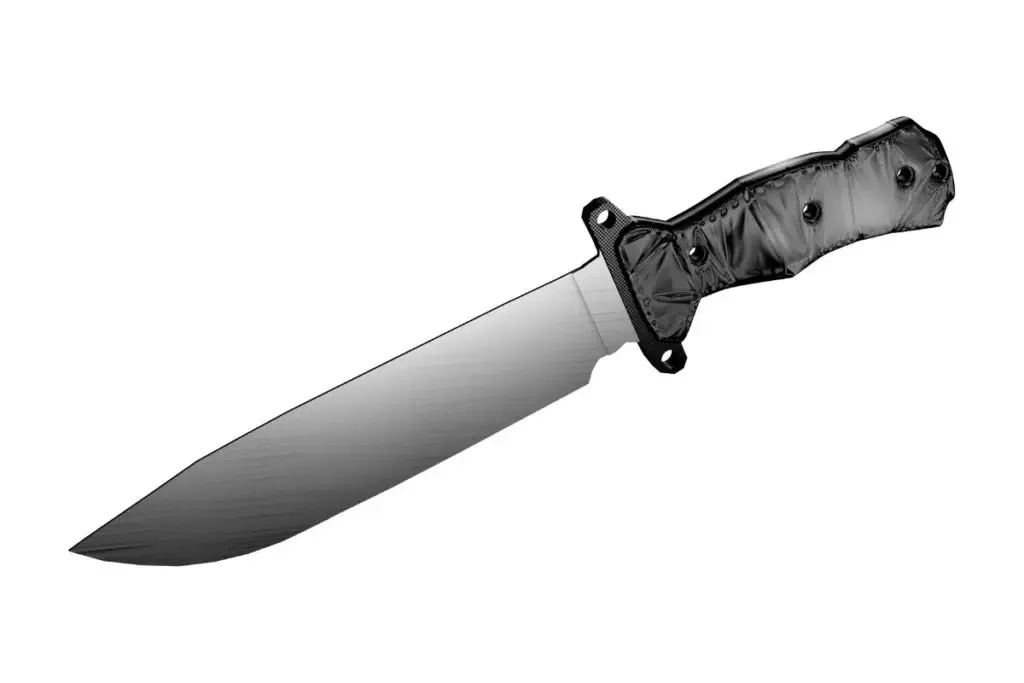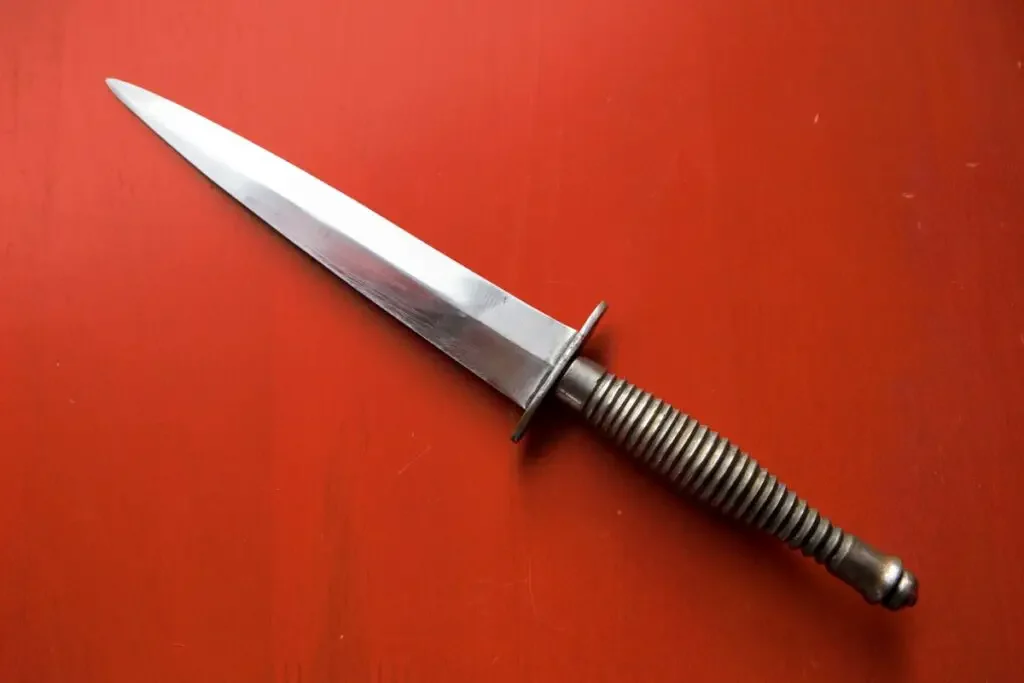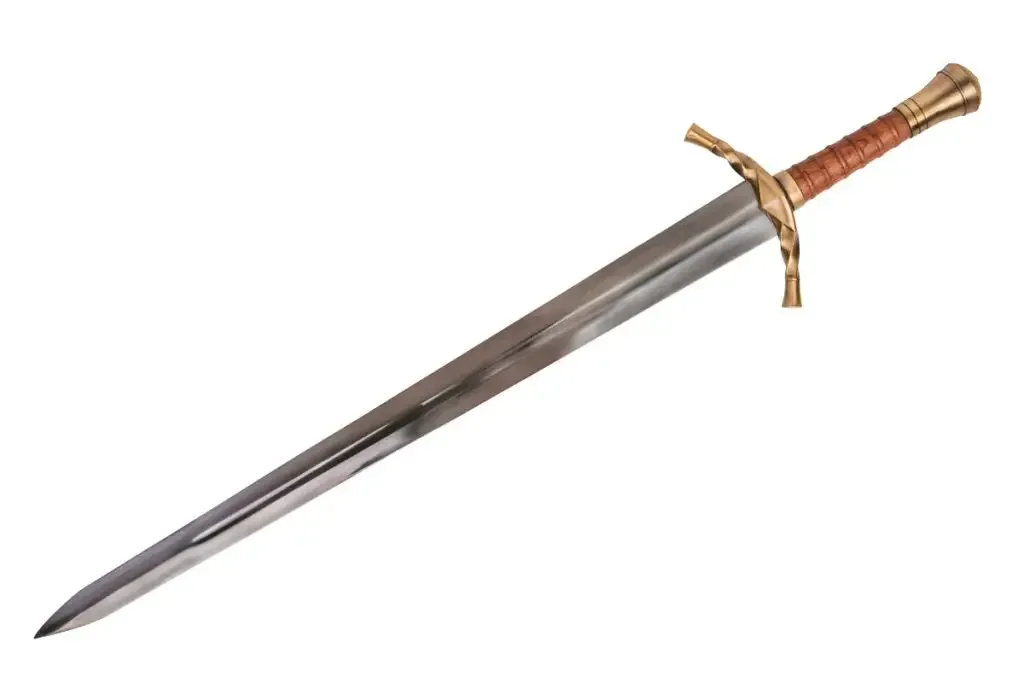As an Amazon Associate, we earn from qualifying purchases with no additional costs for you.
Bladed weapons have always held a unique place in human history. From the ancient battlefields to modern-day martial arts dojos, the knife, dagger, and sword have carved their mark not just on flesh but on the very fabric of cultures worldwide. While seemingly similar, These tools and weapons have distinct characteristics, uses, and significance.
Knives, daggers, and swords have similar characteristics, but each was developed for different purposes. Each purpose has defined the physical characteristics of each blade, giving them characteristics that differentiate each type and make it stand in a class of its own.
Understanding the differences between knives, daggers, and swords is important to be able to distinguish one from the other, especially from the aspect of legality. We will shed light on the knife, dagger, and sword, unraveling their mysteries and highlighting what sets each apart.
If you are interested in a pocket knife that we highly recommend for EDC, check out the Spyderco Para 3 Maxamet here. (Amazon Link)
Knife Vs. Dagger Vs. Sword: Understanding The Differences

Before getting into the physical differences between these blade types, it would be relevant to explore the historical context of each to give us some background.
The knife, dagger, and sword, each with its unique origins and evolution, have played pivotal roles in shaping civilizations and influencing the course of history.
The Knife: The Dawn of Tools
The knife, often considered one of the oldest tools known to humanity, traces its origins back to the Stone Age.
Early humans fashioned knives from sharp-edged rocks, primarily for hunting and basic survival tasks. As civilizations progressed, so did the craftsmanship, leading to the development of bronze and iron knives.
| Era | Material | Primary Use |
| Stone Age | Flint, Obsidian | Hunting, Skinning |
| Bronze Age | Bronze | Cooking, Rituals |
| Iron Age | Iron | Combat, Utility |
TIP: Pocket knives are an ideal way to keep a useful tool available at all times. Read all about how to choose the best blade steel for your pocket knife needs in our article on the topic.
Pocket Knives Blade Steel: The Best One & How To Choose
TIP: Find out my TOP 3 picks of pocket knives if you are interested in buying a pocket knife (Amazon link):
- Victorinox Swiss Army Rangergrip knife: Our favorite feature is the one-hand-opening lock blade, a crucial feature of this tool.
- Opinel No.8 Carbon Pocket Knife: Robust, reliable everyday carry knife, suitable for those who only want a knife blade on their pocket knife.
- Spyderco Para 3 Maxamet Pocket Knife: Lightweight knife featuring a blade made from high-performance Maxamet steel, with a full flat grind for edge durability and easy sharpening.
The Dagger: The Silent Guardian
The dagger, characterized by its double-edged blade, emerged as a weapon of choice for close combat and stealth missions. Historically, daggers were often associated with assassins, spies, and even royalty.
They were not just tools of warfare but also symbols of power and prestige. The Roman pugio and the Indian katar are classic examples of daggers that held both martial and ceremonial significance.
| Culture | Dagger Name | Significance |
| Roman | Pugio | Military and Ceremonial |
| Indian | Katar | Combat and Status Symbol |
The Sword: The Emblem Of Warriors
With its long metal blade, the sword is perhaps the most iconic of all bladed weapons. From the curved scimitars of the Middle East to the straight longswords of Europe, swords have been symbols of military might, noble status, and martial skill. They evolved over time, adapting to the needs of warfare and the advancements in metallurgy.
| Region | Sword Type | Characteristics |
| Middle East | Scimitar | Curved, Single-edged |
| Europe | Longsword | Straight, Double-edged |
| Japan | Katana | Curved, Razor-sharp edge |
Knife: The Essential Tool And Weapon

The knife has been an indispensable companion to humanity for millennia in its many forms and functions. Its origins as a tool for survival have evolved, making it a versatile instrument that transcends cultures, geographies, and eras.
- Origins and Evolution. The knife’s journey began during the early days of human civilization. As a tool, its primary purpose was for hunting and gathering. Early humans utilized sharp-edged stones, giving birth to the first primitive knives. As time progressed and with the advent of the Bronze Age, metallurgy allowed for crafting more durable and sharper knives, enhancing their utility manifold.
- Everyday Utility. In modern times, the knife has become an essential tool for many everyday tasks, from cooking in our kitchens, where it helps in chopping and slicing, to outdoor activities like camping, where it aids in cutting ropes and preparing food. Its compact size and sharp blade make it an invaluable tool for various utility tasks.
- Self-defense and Combat. Beyond its utility, the knife has also been recognized for its potential in close combat situations. Its compactness makes it easy to conceal, and its sharp edge can be lethal in skilled hands. Many martial arts disciplines, such as Krav Maga and Silat, incorporate knife techniques, emphasizing their effectiveness in self-defense scenarios.
- Art and Craftsmanship. The art of knife-making is a revered craft. Artisans and blacksmiths, through generations, have passed down techniques of forging, sharpening, and embellishing knives. From the intricately designed daggers of the Middle East to the precision-crafted Japanese chef knives, the knife is as much a work of art as it is a tool or weapon.
Whether used as a tool for survival, a weapon for defense, or an object of art and craftsmanship, the significance of knives in human history is undeniably profound.
TIP: A knife is an indispensable part of a survival or emergency kit. Find out all the reasons why you should always include a knife in your emergency gear in our article on the topic.
Survival Essentials: Crucial Role of Knife in Survival Kit
Dagger: The Stealthy Companion

With its sleek design and sharp, double-edged blade, the dagger has long been a symbol of stealth, precision, and power. While it shares some similarities with the knife, its historical and cultural significance sets it apart, making it a weapon of intrigue and, often, of great ceremonial importance.
- Origins and Historical Significance. The dagger’s roots can be traced back to ancient civilizations, where it was primarily used as a stabbing weapon in close combat. Unlike the broader swords, the dagger’s design favored quick, precise strikes, making it a preferred weapon for assassinations and covert operations. Historical records from ancient Egypt, Rome, and Greece highlight the dagger’s role in warfare, political power plays, and subterfuge.
- Symbol of Power and Prestige. Beyond the battlefield, the dagger is often seen as a symbol of power and status. Royalty and nobility in various cultures carried ornate daggers as weapons and accessories that denoted their rank and privilege. The ornamental designs, often studded with precious stones and crafted from valuable metals, made these daggers objects of great beauty and significance.
- Modern-day Relevance. In today’s world, while the dagger may not be a common weapon of choice, its influence can still be seen in various forms. It remains a vital part of ceremonial rituals in certain cultures and religions. Additionally, its stealthy and lethal reputation has made it a popular choice in literature, films, and other forms of entertainment, often associated with characters of mystery and agility.
- Martial Arts and Self-defense. The dagger’s compact size and lethal potential have also made it a subject of study in various martial arts disciplines. Techniques focus on maximizing the dagger’s strengths, emphasizing quick strikes and defensive maneuvers. Its role in self-defense remains relevant, especially in scenarios requiring discretion and speed.
The dagger’s rich tapestry of history, art, and culture remains a fascinating subject. From ancient battlefields to modern-day tales of espionage, its presence as the stealthy companion has been both feared and revered, making it an enduring symbol of power and precision.
TIP: Understanding the difference between single and double-bevel knife edges is crucial for choosing the right knife for the job and your skill level. Learn about the differences in our article below.
Single Vs. Double Bevel Knife: What’s The Difference?
Sword: The Symbol Of Power And Honor

With its elongated blade and storied past, the majestic sword stands as an emblem of valor, nobility, and honor. Throughout history, it has been wielded by warriors, knights, and kings, not only as a weapon of war but also as a symbol of the bearer’s status and character.
- Historical Evolution. The sword’s inception can be traced back to ancient civilizations, evolving from simple bronze blades to the finely crafted steel weapons of the medieval era. Each culture and epoch brought its unique design and significance to the sword, from the curved scimitars of the Middle East to the double-edged longswords of Europe.
- A Warrior’s Pride. For a warrior, the sword was more than just a weapon; it was an extension of oneself. It represented one’s skill, honor, and lineage. The act of bestowing a sword, especially in cultures like the medieval European knights or the samurai of Japan, was a rite of passage. It signified that the individual had achieved a certain level of mastery and honor.
- Ceremonial and Symbolic Importance. Beyond the battlefield, swords have held immense ceremonial value. They’ve been used in coronations, knightly ceremonies, and other rituals. In many cultures, a sword’s presence at significant events, like treaties or weddings, symbolized protection, blessing, and authority.
- Modern-day Resonance. While swords may no longer be the primary weapon of choice in modern warfare, their symbolic importance endures. They are often seen in ceremonial roles in military and state functions. Furthermore, the allure of the sword continues in popular culture, with countless films, books, and games drawing inspiration from legendary swords and their wielders.
- Craftsmanship and Artistry. The art of sword-making is a revered tradition. Blacksmiths and artisans, through centuries, have honed techniques to forge blades of exceptional quality and beauty. A well-crafted sword’s intricate patterns, engravings, and balance make it as much an artwork as a weapon.
The sword, with its blend of history, art, and symbolism, remains one of the most iconic artifacts of human civilization. Its legacy as a symbol of power, honor, and craftsmanship continues to inspire and captivate, ensuring its place in tales and traditions for future generations.
TIP: Are you looking to buy a new whetstone? Check out our recommendations (we personally use the first three ones):
Our PRO choice whetstones combo (Amazon links):
- Fixing stone: Whetstone SHAPTON Ceramic KUROMAKU #320
- Sharpening stone: Suehiro CERAX soaking whetstone: Medium #1000
- Finishing stone: Whetstone SHAPTON Ceramic KUROMAKU #5000
Our budget choice (Amazon link): Sharp Pebble Extra Large Sharpening Stone Set
Comparative Analysis Of Knives, Daggers, And Swords
When examining bladed weapons, it’s essential to understand the nuances that set the knife, dagger, and sword apart. While they all share the fundamental characteristic of a sharpened edge designed for cutting or thrusting, their specific features, uses, and historical contexts differ significantly.
Size And Length
The most apparent difference among the three is their size. Knives are typically the smallest, designed for utility and ease of carry.
Daggers, similar in size to some knives, are often slightly larger and primarily designed for combat. With their long blades, swords are unmistakably the largest, designed for open combat and dueling.
Functional Differences
Knives, given their compact size, are versatile tools used for a range of tasks, from cooking to crafting. With their sharp points and often double-edged blades, daggers are optimized for thrusting and stabbing in close combat scenarios.
On the other hand, swords are designed for slashing, thrusting, and parrying, suitable for both offense and defense in battle.
Combat Advantages and Disadvantages
The environment is crucial in determining the weapon’s effectiveness in combat. A dagger or knife might have the advantage in close or confined spaces due to its maneuverability.
In contrast, on an open battlefield, the sword’s reach and weight can deliver powerful blows, making it a formidable weapon.
Cultural And Symbolic Significance
While all three weapons have rich histories, their cultural and symbolic significance varies. Knives, being everyday tools, often symbolize utility and resourcefulness.
Daggers, especially ornate ones, can represent stealth, power, and prestige. Swords, wielded by warriors and leaders, stand as symbols of honor, valor, and authority.
Comparative Characteristics Of Knife, Dagger, And Sword
| Characteristic | Knife | Dagger | Sword |
| Primary Use | Utility | Combat | Combat |
| Blade Edge | Single or Double | Often Double | Typically Double |
| Size | Small | Medium | Large |
| Combat Role | Close combat, utility | Close combat, thrusting | Open combat, slashing and thrusting |
| Symbolism | Resourcefulness, utility | Stealth, power | Honor, valor, authority |
| Common Materials | Steel, iron, bronze | Steel, sometimes ornate with precious metals | High-quality steel, iron |
While the knife, dagger, and sword share some similarities, their distinct characteristics and historical contexts give them a unique identity. Understanding these differences is crucial for appreciating their roles in history, combat, and culture.
Cultural Significance Of Knives, Daggers, And Swords
Beyond their practical applications, bladed weapons have deeply embedded themselves in the cultural and symbolic tapestry of societies across the globe.
The knife, dagger, and sword, each with its unique attributes, have been immortalized in legends, rituals, and ceremonies, reflecting the values, beliefs, and aspirations of the people who revered them.
Knives: Tools Of Tradition And Ritual
Given their ubiquity and utility, knives have found a place in many cultural rituals. In some societies, knives are used in harvest festivals, symbolizing abundance and prosperity.
In others, they play a role in rites of passage ceremonies, marking the transition from childhood to adulthood. The knife’s symbolism often revolves around sustenance, protection, and craftsmanship themes.
Daggers: Emblems Of Power And Sacrifice
With its sharp point and often ornate design, the dagger has been associated with both power and sacrifice.
In ancient Egypt, pharaohs were buried with golden daggers, symbolizing their authority in life and protection in the afterlife.
In some cultures, daggers represent sacrifice and devotion in religious ceremonies. Their dual nature, as instruments of both protection and peril, makes them potent symbols in many cultural narratives.
Swords: Symbols Of Honor And Heroism
Perhaps more than any other weapon, the sword has been romanticized in legends, folklore, and literature. From the legendary Excalibur of King Arthur to the revered katana of the samurai, swords have come to represent honor, valor, and heroism.
They are often seen as extensions of their wielders, embodying the virtues and values of great warriors and leaders. In many cultures, the act of bestowing a sword is a significant event, marking a warrior’s rite of passage or a leader’s ascent to power.
Safety And Legal Considerations
While the knife, dagger, and sword hold historical and cultural significance, their possession and use in modern times come with a set of safety and legal considerations.
As tools and weapons with the potential to cause harm, it’s imperative to understand and adhere to guidelines that ensure the safety of oneself and others.
Safe Handling and Storage
Any blade, whether a knife, dagger, or sword, requires safe handling and storage.
- Training. Proper training is essential before using any bladed weapon, especially for martial or recreational purposes. This ensures that the user understands the weapon’s capabilities and limitations.
- Storage. When not in use, these weapons should be stored securely, away from the reach of children. Using sheaths, scabbards, or locked cabinets can prevent accidental injuries.
- Maintenance. Regular maintenance, including cleaning and sharpening, is crucial. A well-maintained blade is safer and reduces the risk of accidents due to malfunction or breakage.
Legal Restrictions Regarding Knives, Daggers And Swords
Many countries and states have regulations regarding the ownership of knives, daggers, and swords. Some might require permits, while others might ban certain types of blades altogether.
Carrying bladed weapons in public places is often restricted. Concealed carry laws might apply to knives and daggers, and blade length limitations might be in place.
When transporting these weapons, especially across state or national borders, it’s essential to be aware of local laws. Some jurisdictions might require the weapon to be securely packed and declared.
In some regions, allowances are made for bladed weapons with religious or cultural significance. For instance, the Sikh kirpan is considered a religious symbol and might be exempt from certain restrictions. However, even in these cases, there are often guidelines on size and manner of carry.
Owning and using a bladed weapon comes with a responsibility to be aware of its potential dangers. It’s essential to respect the weapon, understand its history and significance, and always prioritize safety.
Adhering to safety guidelines and legal regulations ensures that these weapons can be appreciated and used without posing risks to oneself or society.
Conclusion
The knife, dagger, and sword, each with distinct characteristics and rich history, have been integral to human civilization’s tapestry.
From their roles in survival and combat to their deep-seated cultural and symbolic significance, these bladed weapons have shaped stories, rituals, and traditions across ages and continents.
Recognizing that the knife, dagger, and sword are more than just tools or weapons is essential. They are bridges to our past, symbols of our heritage, and inspirations for tales yet to be told.
Whether you’re a historian, enthusiast, or collector, understanding and appreciation of these blades are essential to your knowledge.
TIP: Whether you are handling a knife, dagger, or sword, maintaining safety in proximity to a tool with a sharp cutting edge is paramount. Read all about knife safety in our article below.
Knife Safety: Essential Insights into Its Importance
